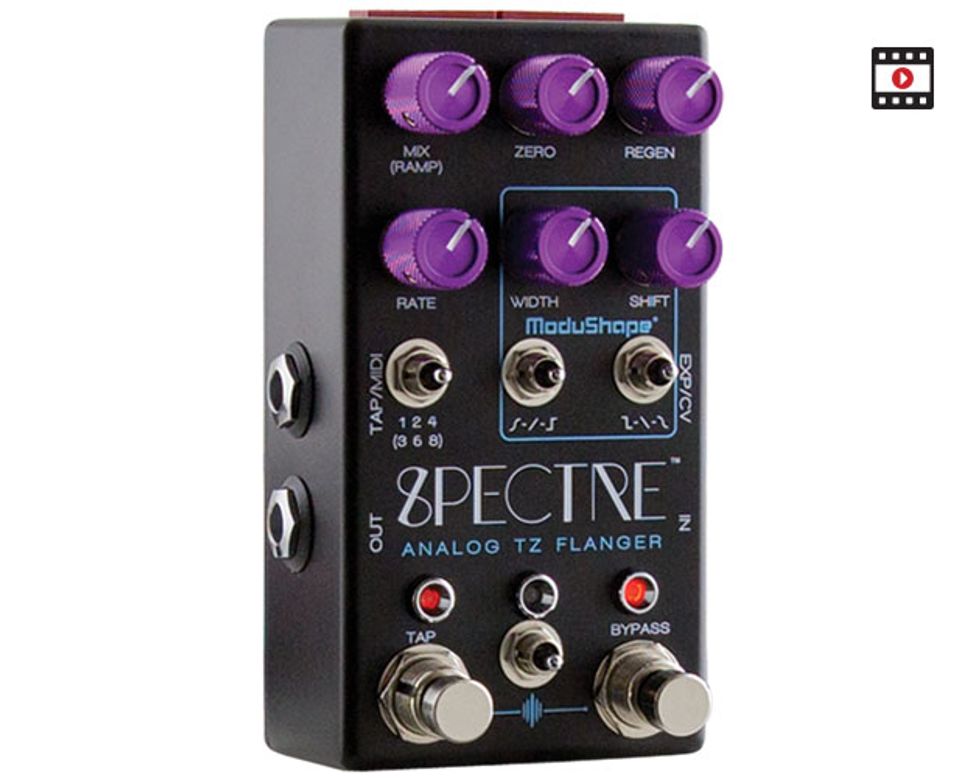I confess: I plugged in Chase Bliss Audio’s new flanger before reading about it. I assumed it was digital. All those controls! There are six knobs, four toggles, four jacks, and 16 tiny DIP switches—more sonic options than you’re likely to find on a flanger of any type—let alone a compact analog unit.
Then I cracked it open. Holy cannoli—that’s one densely packed circuit board! Especially since it’s hand-wired using old-school through-hole components. With all those new-production analog BBD chips and the trimpots needed to calibrate them, it’s no surprise that there’s no battery compartment. (Spectre runs on a standard 9V power supply.)
Bucket All!
Yes, Spectre is a true through-zero analog flanger, which means it employs two analog delay lines. Through-zero is a particularly dramatic flanging sound, wherein the wet signal drops to near silence at the sweep point where the delay signals are directly out of phase. (You can hear the effect on Jimi Hendrix’s “House Burning Down.”)
Spectre is monophonic, with just one input and one output jack, yet it offers extraordinary sonic options. This jibes with Chase Bliss Audio’s signature approach of digitally controlling analog circuits. Now, that may sound like one of the silly circumlocutions some effect manufacturers use to sidestep the off-putting word “digital.” (“Your dry sound remains 100 percent analog!”) But here, it’s true.
But before we explore Spectre’s special skills, know this: This pedal is really, really noisy. Your tolerance for analog hiss may be the factor that determines whether Spectre is right for you.
Hissy Fit
All BBD chips make noise. I love old analog delays and accept noise as part of a BBD effect’s character. But since Spectre combines two delay lines in parallel, there’s at least double the noise of most analog delays. The exact noise amount depends on the wet/dry mix balance—the wetter the noisier. The audio clip above starts with a few seconds of unaffected sound before the pedal kicks in with a 50/50 mix (probably the most common setting for flange effects). At 100 percent wet, the noise is doubled. Listen through headphones and see what you think.
Chase Bliss mastermind Joel Korte knows all about the noise. “The pedal is really designed to have fuzz and distortion in front of it, so noise is not really an issue, especially with the through-zero stuff,” he writes. “I experimented with different noise mitigation techniques, but I felt they all took away something special.” Bear that in mind if you seek clean-toned flanging. (I have a high tolerance for analog noise myself, and I might use Spectre onstage. But I’d be leery of using it in the studio, at least when I’m a hired hand.) But if you can hang with the noise, read on. Spectre does some remarkable things.
Controlled Chaos
There are the expected mix, rate, depth, and feedback controls. An additional shift knob determines whether the sweeps are symmetrical, or if positive sweeps are longer and negative sweeps shorter (or vice versa). You can independently select sine wave, triangle wave, or square wave modulation for each delay line.
Ratings
Pros:
True analog sound. Compact. Extraordinary tone options. Great real-time control.
Cons:
Very noisy.
Tones:
Ease of Use:
Build/Design:
Value:
Street:
$349
Chase Bliss Audio Spectre Analog TZ Flanger
chaseblissaudio.com
Meanwhile, the zero control is like the manual knob on the classic A/DA Flanger. It sets the delay time—generating flange tones at low settings and more chorus-like colors at higher settings.
There’s tap tempo with selectable rhythmic subdivisions, plus a jack to connect an external tap-tempo footswitch (not included). The tap tempo jack also serves as a MIDI control port, though you need a MIDI-to-1/4" adapter (such as the $49 Empress Midibox). You can save three presets, though you must bend over and flick a small toggle to recall them. But the truly killer features concern control functions. The mix knob doubles as a multipurpose control pot. And if you connect an expression pedal (not included), you can sweep settings with your foot.
What settings can you sweep? Whatever the hell you want! On Spectre’s top panel is a bank of 16 DIP switches that determine the control knob’s role. You can choose whether to control the rate, width, feedback, or manual settings, or all of the above. You can also specify sweep range, sweep polarity, and much more. It gets deep.
No matter how conventional or radical though, the effect quality is lovely—thick, immersive, and three-dimensional. It’s just really noisy.
The Verdict
Spectre is an engineering tour-de-force. Have there ever been so many options in a standard-sized stompbox flanger, let alone an analog one? The $349 price tag isn’t excessive, given Spectre’s top-shelf components, high parts count, labor-intensive through-hole build, and extraordinary functionality. The only real drawback is the noise. If you can’t hang with it, conversation over. If you can, you’ll probably enjoy exploring this unique modulation effect.
Watch the Review Demo:








![Rig Rundown: Russian Circles’ Mike Sullivan [2025]](https://www.premierguitar.com/media-library/youtube.jpg?id=62303631&width=1245&height=700&quality=70&coordinates=0%2C0%2C0%2C0)

















